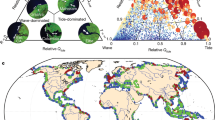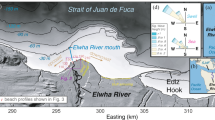Abstract
Over the past few centuries, 25% of the deltaic wetlands associated with the Mississippi Delta have been lost to the ocean1. Plans to protect and restore the coast call for diversions of the Mississippi River, and its associated sediment, to sustain and build new land2,3. However, the sediment load of the Mississippi River has been reduced by 50% through dam construction in the Mississippi Basin, which could affect the effectiveness of diversion plans4,5,6. Here we calculate the amount of sediment stored on the delta plain for the past 12,000 years, and find that mean storage rates necessary to construct the flood plain and delta over this period exceed modern Mississippi River sediment loads. We estimate that, in the absence of sediment input, an additional 10,000–13,500 km2 will be submerged by the year 2100 owing to subsidence and sea-level rise. Sustaining existing delta surface area would require 18–24 billion tons of sediment, which is significantly more than can be drawn from the Mississippi River in its current state. We conclude that significant drowning is inevitable, even if sediment loads are restored, because sea level is now rising at least three times faster than during delta-plain construction.
This is a preview of subscription content, access via your institution
Access options
Subscribe to this journal
Receive 12 print issues and online access
$259.00 per year
only $21.58 per issue
Buy this article
- Purchase on Springer Link
- Instant access to full article PDF
Prices may be subject to local taxes which are calculated during checkout




Similar content being viewed by others
References
Day, J. W. Jr. et al. Restoration of the Mississippi Delta: Lessons from Hurricanes Katrina and Rita. Science 315, 1679–1684 (2007).
Louisiana Coastal Protection and Restoration Authority. Integrated Ecosystem Restoration and Hurricane Protection: Louisiana’s Comprehensive Master Plan for a Sustainable Coast (State of Louisiana, 2007).
United States Army Corps of Engineers. Draft Louisiana Coastal Protection and Restoration Technical Report (US Army Corps of Engineers New Orleans District, 2008).
National Research Council. First Report from the NRC Committee on the Review of the Louisiana Coastal Protection and Restoration (LACPR) Program (National Academy of Sciences, 2008).
Meade, R. H. et al. Surface Water Hydrology (Geological Society of America, 1990).
Kesel, R. H. et al. An approximation of the sediment budget of the lower Mississippi River prior to major human modification. Earth Surf. Process. Landf. 17, 711 (1992).
Peltier, W. R. & Fairbanks, R. G. Global glacial ice volume and Last Glacial Maximum duration from an extended Barbados sea level record. Quat. Sci. Rev. 25, 3322–3337 (2006).
Törnqvist, T. E. et al. How stable is the Mississippi Delta? Geology 34, 697–700 (2006).
Blum, M. D. et al. Ups and downs of the Mississippi delta. Geology 36, 675–678 (2008).
Kesel, R. H. A revised Holocene geochronology for the lower Mississippi valley. Geomorphology 101, 78–89 (2008).
Stanley, D. J. & Warne, A. G. Worldwide initiation of Holocene marine deltas by deceleration of sea-level rise. Science 265, 228–231 (1994).
Roberts, H. H. Dynamic changes of the Holocene Mississippi river delta plain: The delta cycle. J. Coast. Res. 13, 605–627 (1997).
Törnqvist, T. E. et al. A revised chronology for Mississippi River subdeltas. Science 273, 1693–1696 (1996).
Penland, P. S. et al. The transgressive depositional systems of the Mississippi delta plain: A model for barrier shoreline and shelf sand development. J. Sedim. Petrol. 58, 932–949 (1988).
Kulp, M. A. et al. Latest Quaternary stratigraphic framework of the Mississippi delta region. Trans. Gulf Coast Assoc. Geol. Soc. 52, 572–582 (2002).
Goodbred, S. L. & Kuehl, S. A. Floodplain processes in the Bengal Basin and the storage of Ganges–Brahmaputra river sediment: An accretion study using 137Cs and 210Pb geochronology. Sedim. Geol. 121, 239–258 (1998).
Allison, M. A. et al. The importance of floodplain sedimentation for river sediment budgets and terrigenous input to the oceans: Insights from the Brahmaputra–Jamuna River. Geology 26, 175–178 (1998).
Meckel, T. A. An attempt to reconcile subsidence rates determined from various techniques in southern Louisiana. Quat. Sci. Rev. 27, 1517–1522 (2008).
Gonzales, J. L. & Törnqvist, T. E. Coastal Louisiana in crisis: Subsidence or sea level rise? Eos 87, 493–498 (2006).
Bindoff, N. et al. Climate Change 2007: The Physical Science Basis. Contribution of Working Group I to the Fourth Assessment Report of the Intergovernmental Panel on Climate Change (Cambridge Univ. Press, 2007).
Meehl, G. A. et al. Climate Change 2007: The Physical Science Basis. Contribution of Working Group I to the Fourth Assessment Report of the Intergovernmental Panel on Climate Change (Cambridge Univ. Press, 2007).
Pfeffer, W. T. et al. Kinematic constraints on glacier contributions to 21st-century sea-level rise. Science 321, 1340–1343 (2008).
Barras, J. A. et al. Historic and Predicted Coastal Louisiana Land Changes: 1978–2050 (US Geological Survey Open File Report 03-334. US Geological Survey, National Wetlands Research Center, 2003).
Kim, W. et al. Coastal Louisiana Ecosystem Assessment & Restoration (CLEAR) Program: A Tool to Support Coastal Restoration Vol. IV, Ch. 10 (Final Report to Department of Natural Resources, Coastal Restoration Division, Contract No. 2512-06-02, 2008).
Reed, D. J. Sea-level rise and coastal marsh sustainability: Geological and ecological factors in the Mississippi delta plain. Geomorphology 48, 233–243 (2002).
Baumann, R. H. et al. Mississippi deltaic wetland survival—sedimentation versus coastal submergence. Science 224, 1093–1095 (1984).
Turner, R. et al. Wetland sedimentation from Hurricanes Katrina and Rita. Science 313, 1713–1715 (2006).
Törnqvist, T. E. et al. Mississippi Delta subsidence primarily caused by compaction of Holocene strata. Nature Geosci. 1, 173–176 (2008).
Divins, D. L. & Metzger, D. NGDC Coastal Relief Model, 88.5–92.5∘ W and 28.5–32∘ N. <http://www.ngdc.noaa.gov/mgg/coastal/coastal.html>.
Acknowledgements
This analysis was supported by the Harrison Professorship in the Department of Geology and Geophysics at Louisiana State University (M.D.B.), the LSU Boyd Professorship at Louisiana State University (H.H.R) and a US National Science Foundation grant (M.D.B.). We thank M. Garvin, Louisiana State University Department of Geology and Geophysics, for processing satellite imagery and DEM data to create submergence maps, and we thank numerous colleagues for discussions about the Mississippi delta region, coastal restoration, the subsidence problem and sea-level change over the years. We benefited greatly from comments by T. Törnqvist.
Author information
Authors and Affiliations
Contributions
Modelling of submergence and sediment mass balance was conducted by M.D.B. Previous work on the lower Mississippi Valley, the Mississippi Delta and the Gulf of Mexico shoreline by H.H.R. and M.D.B. provided data and context for this study.
Corresponding author
Supplementary information
Supplementary Information
Supplementary Information (PDF 1286 kb)
Rights and permissions
About this article
Cite this article
Blum, M., Roberts, H. Drowning of the Mississippi Delta due to insufficient sediment supply and global sea-level rise. Nature Geosci 2, 488–491 (2009). https://doi.org/10.1038/ngeo553
Received:
Accepted:
Published:
Issue Date:
DOI: https://doi.org/10.1038/ngeo553
This article is cited by
-
Cold fronts control multiscale spatiotemporal hydroperiod patterns in a man-made subtropical coastal delta (Wax Lake Region, Louisiana USA)
Ocean Dynamics (2024)
-
Accelerating Elevation Gain Indicates Land Loss Associated with Erosion in Mississippi River Deltaic Plain Tidal Wetlands
Estuaries and Coasts (2024)
-
Acceleration of U.S. Southeast and Gulf coast sea-level rise amplified by internal climate variability
Nature Communications (2023)
-
Anthropogenic interventions on land neutrality in a critically vulnerable estuarine island ecosystem: a case of Munro Island (India)
Scientific Reports (2023)
-
A river delta in transition
Nature Sustainability (2023)



